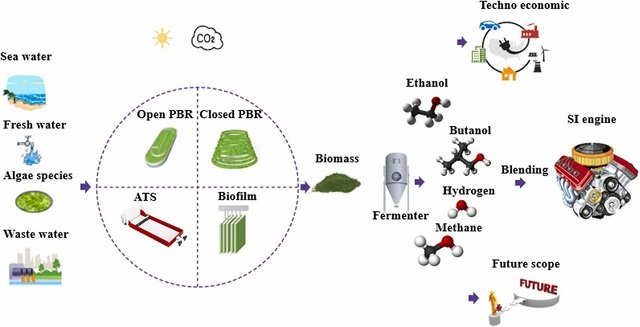USA.- Because fossil fuels emit pollutants that are harmful to both the environment and public health, researchers are diligently exploring more sustainable alternatives. One of these alternatives is biofuels.
Biofuels are renewable energy sources created using plants like corn or switchgrass that can be grown as annual or perennial crops. Another source used to create biofuel is algae – both single-celled microalgae and macroalgae such as kelp. Though algal biofuels are a more sustainable alternative to fossil fuels, there remains room to improve the production of the algae used to create them.
Ken Reardon, the Jud and Pat Harper Professor of Chemical and Biological Engineering, is leading a $2.1 million project that aims to increase algae yield by improving carbon dioxide utilization. The three-year project is part of an effort led by the Department of Energy’s Office of Energy Efficiency & Renewable Energy to improve the cost-competitiveness and environmental sustainability of microalgae-based fuels and products. A team of five faculty members at Colorado State University and three researchers at the National Renewable Energy Laboratory (NREL) will collaborate to achieve the project goals of 1) improving delivery of CO2 to algae and 2) enhancing algae’s consumption of the CO2.
The project is also a partnership with two companies. New Belgium Brewing will provide CO2 from their fermentation processes, and Qualitas Health, a company that produces omega-3 nutraceuticals from algae, will help test the improved CO2 delivery technology at their cultivation site in Imperial, Texas.
Delivery: Bringing CO2 to the algae
For mass cultivation purposes, microalgae are typically grown in large, shallow ponds that allow light to penetrate the water to the algae cells. Like plants, algae require sunlight, CO2, and nutrients to grow. To supply CO2, air is sparged, or pushed through small holes in a tube, into the bottom of pond. Using this delivery method, much of the CO2 bubbles to the surface and is wasted, rather than being used by the algae.
To improve delivery of the CO2 to the microalgae culture, Reardon will work with Travis Bailey, associate professor in the Department of Chemical and Biological Engineering, and NREL partner Deanne Sammond to design a polymeric membrane containing an enzyme that will convert CO2 into water-soluble bicarbonate, which the algae can use to grow. This membrane will transfer CO2 into the water much more effectively than sparging.
Stay Always Informed
Join our communities to instantly receive the most important news, reports, and analysis from the aquaculture industry.
David Dandy, professor in the Department of Chemical and Biological Engineering, will develop a computational model that predicts when and where in the pond the algae will grow fastest, allowing the bicarbonate to be targeted to those locations. To avoid excess delivery of the bicarbonate, a laser monitoring system devised by an NREL partner will detect when there’s too much CO2 at the surface of the pond.
“We’ll have the ability to deliver more bicarbonate than is currently possible,” said Reardon. “We want to be certain we’re putting the bicarbonate in where and when the algae will need it most.”
Uptake: Consuming CO2
Once the delivery method is perfected, the algae will be modified to be able to keep up with the increase in bicarbonate. The team is leveraging two approaches to improving the algae. The first will be led by Graham Peers, associate professor in the Department of Biology, who will genetically engineer the algae to uptake and metabolize bicarbonate faster than they normally would. NREL partner Lieve Laurens will utilize a natural selection approach that involves selecting genetically superior strains as algae are brown in bicarbonate-rich environments.
“We’re trying two approaches so we’re sure to have at least one successful modification,” said Reardon. “Each version could also be used for different applications.”
While Peers’ approach results in a genetically modified organism (GMO), Laurens’ does not. Some companies prefer to use GMO-free algae in their products, so creating these two options allows for more diverse applications.
Quantifying success
Measuring whether or not the delivery and uptake improvements are effective is up to Jason Quinn, assistant professor in the Department of Mechanical Engineering, and NREL partner Ryan Davis. Using a life-cycle assessment to gauge environmental sustainability of the process and a techno-economic analysis to estimate cost, Quinn and Davis will determine whether the team succeeded in improving cost-competitiveness through their CO2 utilization improvements.
“I’m confident we’ll be able to increase productivity of a system that will produce more biomass,” said Reardon. “And I’m convinced we’ll exceed our target for improved CO2 utilization.”
Editor at the digital magazine AquaHoy. He holds a degree in Aquaculture Biology from the National University of Santa (UNS) and a Master’s degree in Science and Innovation Management from the Polytechnic University of Valencia, with postgraduate diplomas in Business Innovation and Innovation Management. He possesses extensive experience in the aquaculture and fisheries sector, having led the Fisheries Innovation Unit of the National Program for Innovation in Fisheries and Aquaculture (PNIPA). He has served as a senior consultant in technology watch, an innovation project formulator and advisor, and a lecturer at UNS. He is a member of the Peruvian College of Biologists and was recognized by the World Aquaculture Society (WAS) in 2016 for his contribution to aquaculture.



